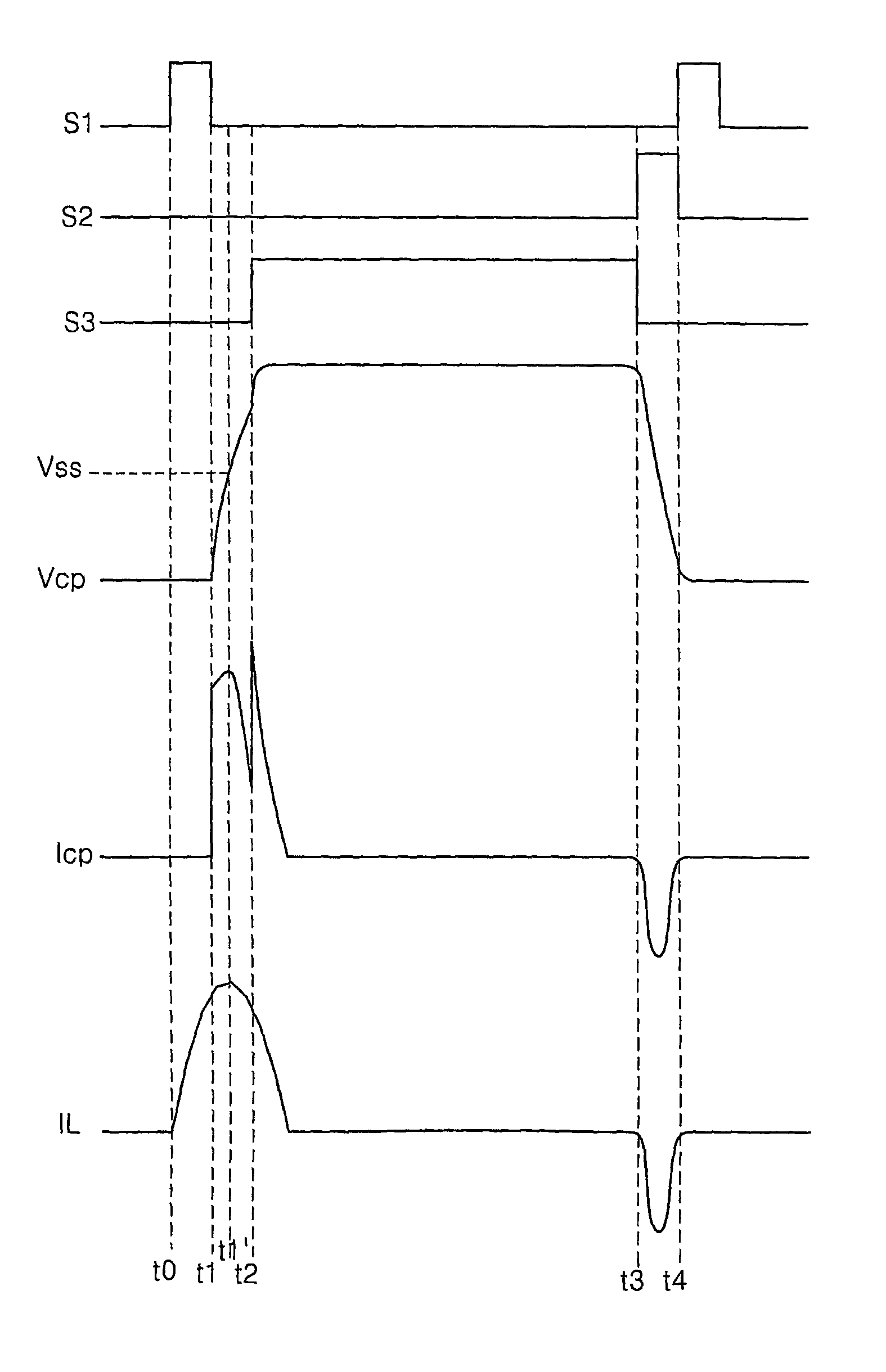Energy recovering circuit with boosting voltage-up and energy efficient method using the same
a technology of energy recovery circuit and power supply, which is applied in the direction of dc-dc conversion, power conversion systems, instruments, etc., can solve the problems of increasing energy loss, and reducing the energy recovery efficiency of the panel. , to achieve the effect of improving the energy recovery efficiency and reducing the charging time of the panel
- Summary
- Abstract
- Description
- Claims
- Application Information
AI Technical Summary
Benefits of technology
Problems solved by technology
Method used
Image
Examples
first embodiment
[0087]Referring to FIG. 3, an energy recovering circuit according to the present invention includes an capacitor Css, an inductor L and a first switch S1 connected to form a closed loop; a second switch S2 connected, via a second node n2, to a panel capacitor Cp; and a third switch S3 connected between a second node n2 and a sustaining voltage source vs.
[0088]The panel capacitor Cp represents a capacitance value of the panel, and reference numerals Re and R-Cp represent parasitic resistances of an electrode and a cell provided at the panel, respectively. Each of the switches S1, S2 and S3 is implemented by a semiconductor switching device, for example, MOS FET, IGBT, SCR, BJT and etc.
[0089]While the first switch S1 is turned on, there is formed a closed loop of electric current which starts from the terminal of one side of the capacitor Css and is connected to the terminal of another side of the capacitor Css, via the inductor L and the first switch S1. Electric current is accumulat...
second embodiment
[0104]Referring to FIG. 8, there is shown an energy recovering circuit according to the present invention.
[0105]Referring to FIG. 8, an energy recovering circuit according to a second embodiment of the present invention includes an capacitor Css, an inductor L, a first switch S1 and a fourth switch S4 connected to form a closed loop; a second switch S2 commonly connected, via a first node n1, to the first and the fourth switches S1 and S4 and connected, via a second node n2, to a panel capacitor Cp; and a third switch S3 connected between a second node n2 and a sustaining voltage source vs.
[0106]Each of the switches S1, S2 and S3 is implemented by a semiconductor switching device, for example, MOS FET, IGBT, SCR, BJT and etc.
[0107]When the first switch S1 and the fourth switch S4 are turned on, there is formed a closed loop of electric current which starts from the terminal of one side of the capacitor Css and is connected to the terminal of another side of the capacitor Css, via th...
third embodiment
[0117]FIG. 11 shows an energy recovering circuit according to the present invention.
[0118]Referring to FIG. 11, an energy recovering circuit according to a third embodiment of the present invention includes an capacitor Css, an inductor L and a first switch S1 connected to form a closed loop; a bridge circuit 10 commonly connected, via a first node n1, to the inductor L and the first switch S1 and connected, via a second node n2, to a panel capacitor Cp; a third switch S3 connected between a second node n2 and a sustaining voltage source vs; and a fourth switch S4 connected between the second node n2 and a ground voltage source GND.
[0119]The bridge circuit 10 consists of diodes Dc1, Dc2, Dr1 and Dr2 connected in a bridge type between the first node n1 and the second node n2, and a second switch S2 connected to the diodes Dc1, Dc2, Dr1 and Dr2. The bridge circuit 10 controls a current path upon the charge / discharge time of the panel.
[0120]Each of the switches S1, S2 and S3 is impleme...
PUM
 Login to View More
Login to View More Abstract
Description
Claims
Application Information
 Login to View More
Login to View More - R&D
- Intellectual Property
- Life Sciences
- Materials
- Tech Scout
- Unparalleled Data Quality
- Higher Quality Content
- 60% Fewer Hallucinations
Browse by: Latest US Patents, China's latest patents, Technical Efficacy Thesaurus, Application Domain, Technology Topic, Popular Technical Reports.
© 2025 PatSnap. All rights reserved.Legal|Privacy policy|Modern Slavery Act Transparency Statement|Sitemap|About US| Contact US: help@patsnap.com



